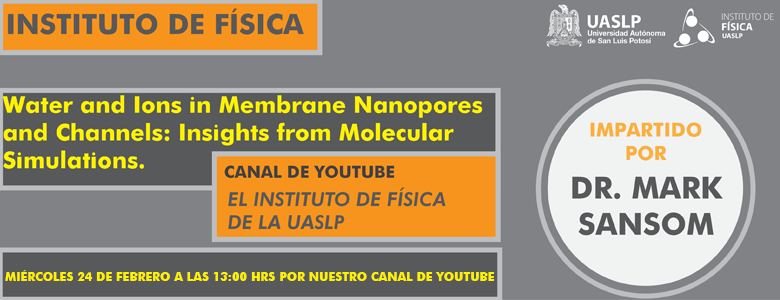
Resumen: Ion channels are proteins which form gated nanopores in biological membranes. Many
channels exhibit hydrophobic gating, whereby functional closure of a pore occurs by local de-
wetting. Molecular dynamics simulations can be used to explore the dynamic behaviour of
water within nanopores and biological channels [1]. Simulation studies of the behaviour of
water in idealised models of nanopores have revealed aspects of the organization and
dynamics of nano-confined water, including wetting/de-wetting in narrow hydrophobic
nanopores. The pentameric ligand gated ion channels (pLGICs) provide a biologically
important example of hydrophobic gating. Molecular simulation studies comparing additive
vs. polarisable models indicate predictions of hydrophobic gating are robust to the model
employed. However, polarisable models suggest favourable interactions of hydrophobic pore-
lining regions with chloride ions, of relevance to both synthetic carriers and to channel
proteins [2]. Electrowetting of a closed pLGIC hydrophobic gate requires too high a voltage
to occur physiologically, but may inform designs of for switchable nanopores [3]. Global
analysis of ~200 channels yields a simple heuristic for structure-based prediction of (closed)
hydrophobic gates. An overall picture emerges whereby the behaviour of water in a nanopore
or channel may be predicted as a function of its hydrophobicity and radius [4][5]. Simulation-
based analysis is shown to provide an aid to interpretation of functional states of new channel
structures.
References
[1] Lynch, C.I., Rao, S., & Sansom, M.S.P. (2020) Water in nanopores and biological
channels: a molecular simulation perspective. Chem. Rev. 120: 10298–10335.
[2] Klesse, G., Rao, S., Tucker, S.J. & Sansom, M.S.P. (2020) Induced polarization in
molecular dynamics simulations of the 5-HT 3 receptor channel. J. Amer. Chem. Soc. 142:
9415-9427
[3] Klesse, G., Rao, S., Tucker, S.J. & Sansom, M.S.P. (2020) Electric field induced wetting
of a hydrophobic gate in a model nanopore based on the 5-HT 3 receptor channel. ACS Nano
14:10480–10491
[4] Rao, S., Klesse, G., Stansfeld, P.J., Tucker, S.J., & Sansom, M.S.P. (2019) A heuristic
derived from analysis of the ion channel structural proteome permits the rapid identification
of hydrophobic gates. PNAS 116: 13989-13995.
[5] Rao, S., Klesse, G., Lynch, C.I., Tucker, S.J. & Sansom, M.S.P. (2021) Molecular
simulations of hydrophobic gating of pentameric ligand gated ion channels: insights into
water and ions. J. Phys. Chem. B. 125: 981–994











